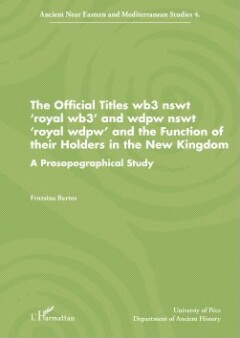Oldal 119 [119]
refers to a campaign under the joint reign of Hatshepsut and Thutmose III, which was
led by the latter. 97
The second stage of his career places Qenamun in the northern region as h3tj-" n Mn-nfr
‘mayor of Memphis’ and jmj-r3 snw.tj ‘overseer of the double granary’. Van Siclen suggests
that the appointment of Qenamun to ‘mayor of Memphis’ might have been a reward from
Thutmose III for his loyal service during the military campaign or campaigns.*” Gessler¬
Léhr mentions Intef and his appointment to ‘mayor of Thinis’ as a parallel, who also got
this position as a reward for his military services under the reign of the same king.*” The
title ‘overseer of the double granary’ seems to be closely linked to that of ‘mayor of Mem¬
phis’, since one of the main agricultural tasks of the mayor as a settlement-leader was to
manage agricultural activities in order to ensure a sufficient food supply for the population
on the one hand, and on the other hand, to collect the surplus in the form of taxes. He was
also responsible for the collection and transportation of taxes as well as grain and other
commodities.*”°
Although Qenamun is supposed to have finished his career in the north in Memphis,
he moved back to the south to prepare his burial in Thebes. Although his tomb has not
been discovered, funerary cone DM 23 leaves no doubt that it existed in this necropolis.
The appearance of the official title ‘royal wb?’ and the epithet mh-jb mnh n nb B.wj ‘excel¬
lent confidant of the lord of the Two Lands’ on both the statue and the funerary cone
connects the two objects to the same person, currently under discussion, whose identi¬
fication with anyone of the same name was unsuccessful. Barakat considered three
well-known persons as the possible owner of the stele: 1. the ‘steward’ Qenamun, owner
of TT 93; 2. the ‘mayor of Thebes’ Qenamun, owner of TT 162; 3. the ‘royal scribe’ Qena¬
mun, owner of TT 412. His most possible candidate was the owner of TT 93, and he
supposed that the statue belonged to the early stage of his career under Thutmose III.**
This identification was not substantiated enough based on two identical titles and one
identical epithet of the two persons, and what Barakat had not considered, and what
contradicted his theory, was the existence of the funerary cone, which excluded all the
possible candidates who had identified the tomb with the funerary cone that belonged
#7 Spalinger, 2006‘, 352-355. In his biographical inscription Montuiui mentions a campaign launched
against Nubia, in which he participated with Thutmose III, presumably in the later stage of his reign.
For the text, see Helck, 1955-1958, 1466-1468; for further information on Montuiui, see p. 123.
38 Van Siclen III, 1991, 159.
3% Gessler-Löhr, 1997, 36.
#° Helck, 1958, 235-236; van den Boorn, 1988, 242-243; Van Siclen III, 1991, 159; Gessler-Löhr, 1997, 36.
° Barakat, 1983, 89-91. Mälek also identifies him wrongly with the owner of TT 93, see Malek, 1987,
135, n 72.
>

